Are you tired of overcooked or undercooked rice? Soaking rice before cooking in a rice cooker could be the solution you’ve been looking for. Soaking helps improve the taste, texture and nutritional value of rice, ensuring it comes out fluffy and perfectly cooked every time.
When it comes to rice cookers, the soaking step is often overlooked, but it’s an essential part of the process. Not only does it help soften the rice, but it also allows the grains to absorb more water evenly, which results in even cooking. Additionally, soaking rice removes excess starch from the grains, which can cause clumping and stickiness.
If you want to take your rice cooking to the next level, read on to learn more about the benefits of soaking rice before cooking in a rice cooker, as well as how to do it properly.
Key Takeaways:
- Soaking rice before cooking in a rice cooker is essential for optimal texture and taste.
- Soaking removes excess starch and allows the grains to absorb water evenly.
- Proper soaking time and water-to-rice ratio are crucial for best results.
How to Soak Rice Before Cooking
If you want to cook perfect rice in your rice cooker, it is essential to learn how to properly soak the rice beforehand. Soaking rice helps to break down the starches and make it easier to digest, as well as improve the texture and flavor.
The following steps will guide you through the process of soaking rice before cooking in your rice cooker:
- Measure the desired amount of rice and place it in a large bowl.
- Rinse the rice thoroughly with cold water to remove any dirt or debris.
- Fill the bowl with enough water to cover the rice by about an inch.
- Add a pinch of salt and stir gently.
- Cover the bowl with a lid or plastic wrap and let it soak for at least 30 minutes, but ideally for 1-2 hours.
The ideal water-to-rice ratio for soaking is 2:1, which means two cups of water for one cup of rice. However, if you prefer firmer or softer rice, adjust the amount of water accordingly.
After the soaking process is complete, drain the rice using a fine-mesh strainer and rinse it again to remove any excess starch. Your rice is now ready to be cooked in the rice cooker as usual!
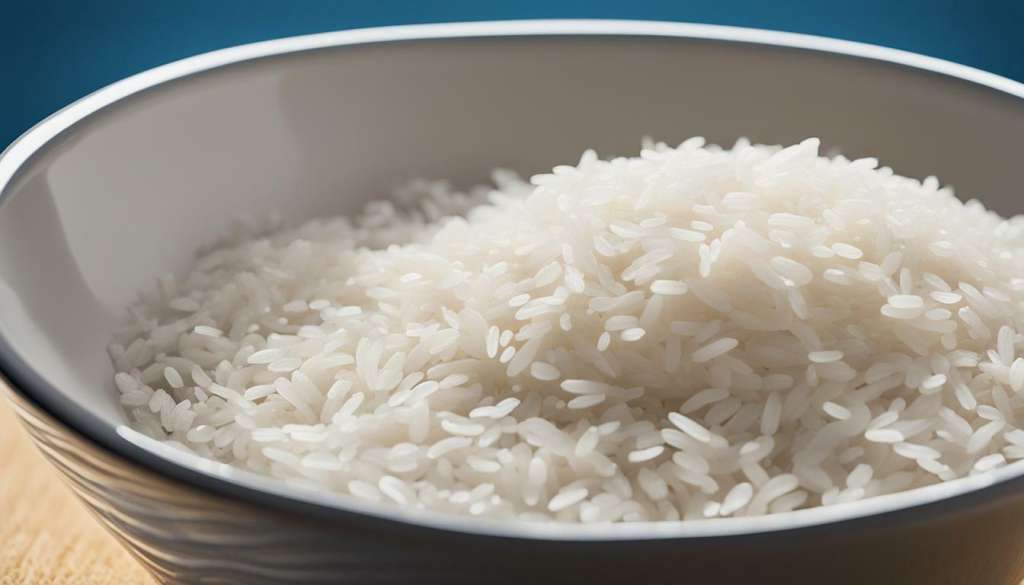
Tip: For an extra boost of flavor, you can also add herbs or spices to the soaking water, such as garlic, ginger, or bay leaves.
Why Soak Rice Before Cooking Matters
Soaking rice before cooking is a crucial step to achieving perfectly cooked, fluffy rice in a rice cooker. But why does soaking matter?
Firstly, soaking rice can improve its texture. When rice is soaked, the grains absorb water and become more plump. This helps them to cook evenly, resulting in a softer and fluffier texture. Additionally, soaking rice can help to reduce cooking time, as the grains absorb some of the water and cook faster.
But it’s not just about texture and cooking time. Soaking rice can also enhance its nutritional value. According to studies, soaking rice can help to reduce its phytic acid content, which can inhibit the absorption of important minerals like zinc and iron. Soaking can also improve the bioavailability of other nutrients, such as folate and vitamin B6.
However, it’s important to note that the benefits of soaking rice depend on the specific type of rice being used. For example, some types of rice, such as basmati or jasmine rice, may benefit more from soaking than others.
Overall, soaking rice before cooking in a rice cooker is a simple yet effective way to improve the texture, flavor, and nutritional value of your rice. Plus, it can save you time and energy in the long run.
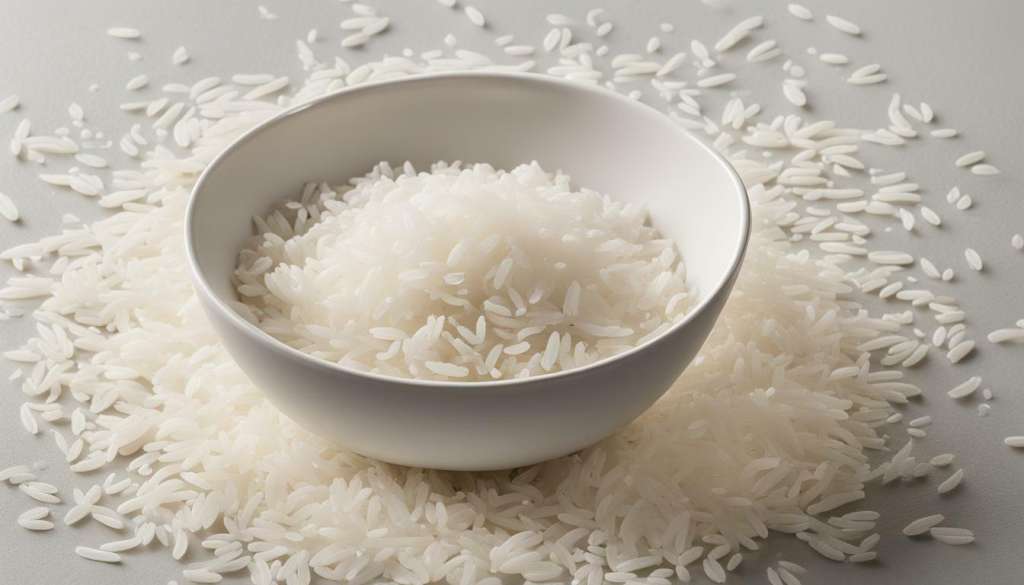
“Soaking rice can improve its texture. When rice is soaked, the grains absorb water and become more plump.”
Benefits of Soaking Rice
Soaking rice before cooking in a rice cooker offers various benefits that go beyond just improving the flavor and texture of the cooked rice. This section will explore some of the specific advantages of soaking rice and how they can impact your health and cooking routines.
Increased Digestibility
Soaking rice can help break down its complex carbohydrates, making it easier to digest and absorb nutrients. This can be particularly beneficial for individuals with digestive issues or those who struggle with bloating or discomfort after eating rice.
Improved Nutrient Absorption
Soaking rice can increase the availability of certain nutrients, such as iron, zinc, and magnesium, making them easier for your body to absorb. This can help enhance your overall nutrient intake and support various bodily functions.
Enhanced Taste
Soaking rice before cooking can improve its taste and texture by allowing it to absorb water and cook more evenly. This can yield fluffier and more flavorful rice that is more enjoyable to eat.
Furthermore, soaking rice can lead to reduced cooking time, as it softens the grain and reduces the required cooking time for optimal results. Overall, soaking rice is a simple and effective way to elevate your rice cooking skills and enjoy better-tasting, healthier rice dishes.
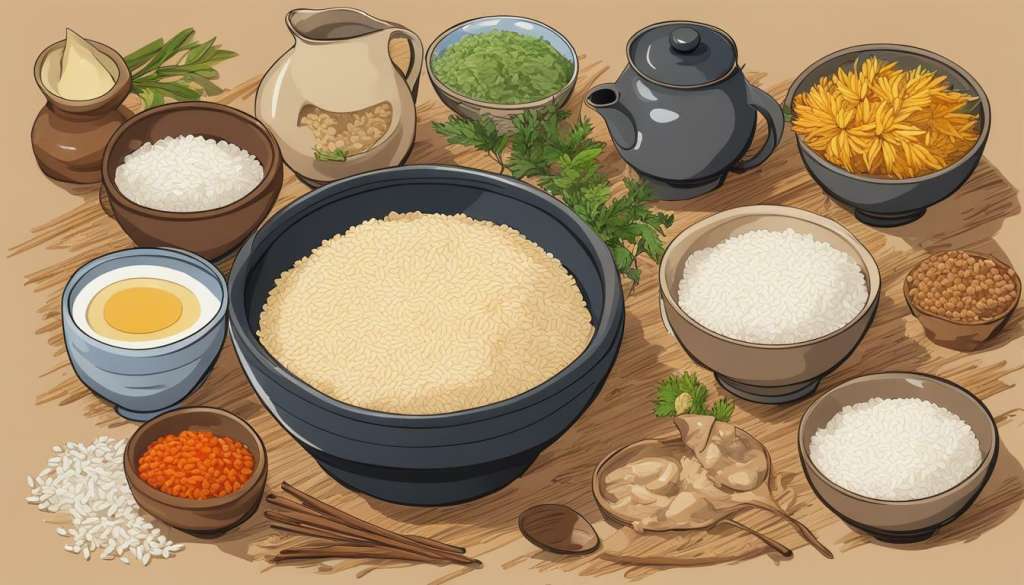
Rice Cooking Tips for Rice Cooker
Cooking rice in a rice cooker is a simple and convenient way to prepare this staple food. However, there are still a few tips and tricks that can elevate your rice cooking game. Here are some essential rice cooking tips for your rice cooker:
- Measurements Matter: Use the recommended water-to-rice ratio for your rice variety and adjust it based on how you prefer your rice. A ratio of 1:1.5 (one cup of rice to 1.5 cups of water) is a good starting point for most white rice.
- Wash the Rice: Rinse your rice thoroughly before cooking to remove excess starch and impurities. This helps to prevent the rice from becoming too sticky or mushy.
- Type of Rice: Different types of rice require different cooking times and water-to-rice ratios. For example, brown rice and wild rice require more water and a longer cooking time than white rice.
- Avoid Disturbing the Rice: Once you’ve started cooking, avoid opening the lid or stirring the rice. This can disrupt the cooking process and affect the texture of the rice.
Try out some unique rice cooker recipes to add some variety to your meals. For instance:
| Rice Cooker Risotto | Rice Cooker Pilaf |
|---|---|
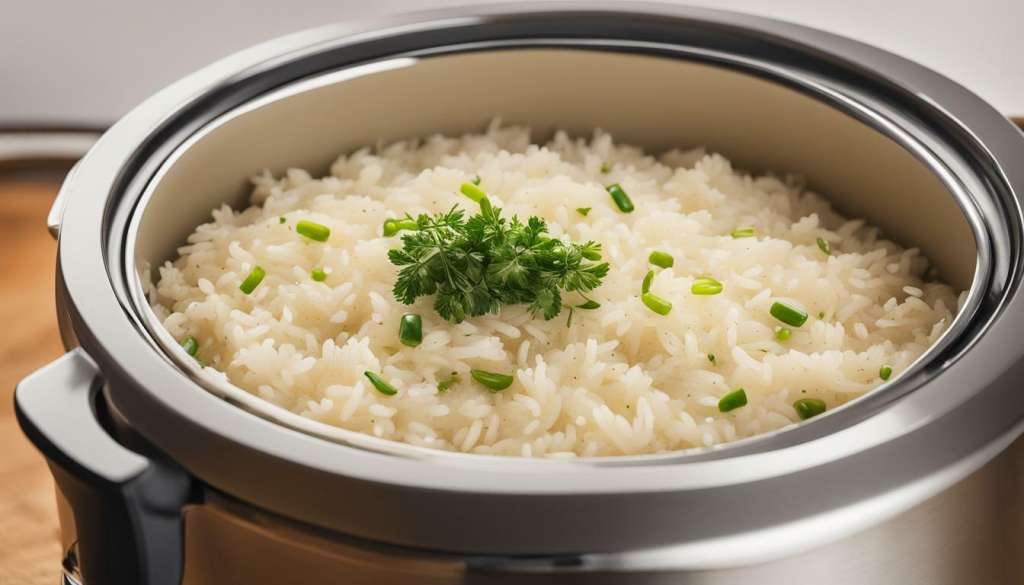 |
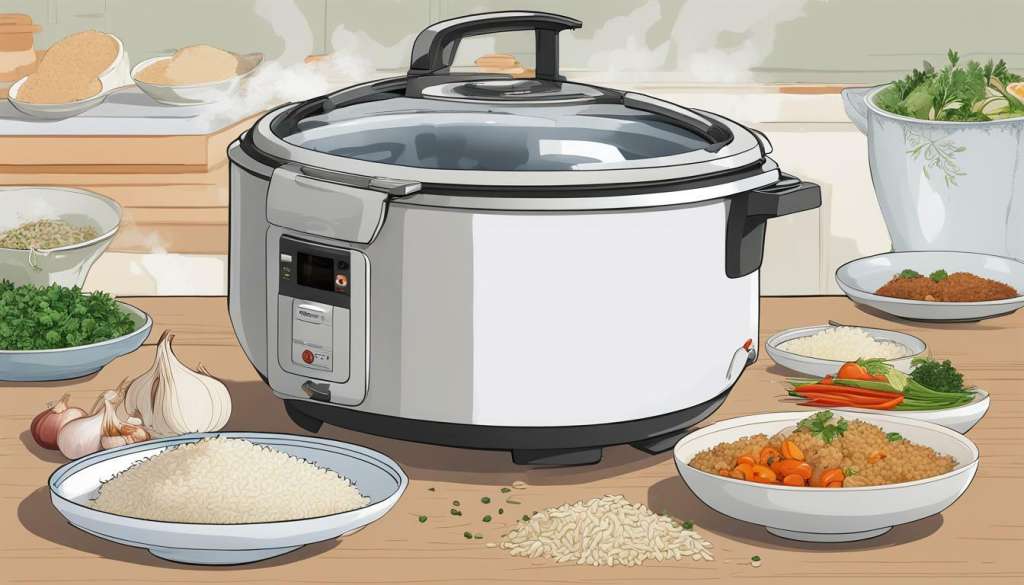 |
| Add Arborio rice, chicken broth, butter, and Parmesan cheese to your rice cooker and cook on the “white rice” setting for a creamy and flavorful risotto. | Sautee sliced onions, garlic, and your favorite spices in the rice cooker, then add rice and chicken broth. Cook on “white rice” setting for a delicious and fragrant pilaf. |
With these rice cooking tips and recipes, you can easily master the art of cooking rice in a rice cooker.
Techniques for Cooking Rice with a Rice Cooker
Cooking rice in a rice cooker is a convenient and efficient way to prepare this staple food. However, there are different techniques you can use to achieve different results. Below are some common rice cooking techniques that you can try:
Steaming Method
This is the most basic method for cooking rice in a rice cooker. Simply add rice and water to the rice cooker and turn it on. Once the rice is cooked, let it rest for a few minutes before fluffing with a fork.
The steaming method works for most types of rice and is ideal for those who prefer their rice soft and fluffy. It does not require much attention, making it perfect for busy days.
Pilaf Method
The pilaf method involves sautéing rice in oil or butter before adding water and cooking it in a rice cooker. This technique adds extra flavor and texture to the rice and is great for making rice dishes like biryani or fried rice.
To use this method, sauté the rice in a little oil or butter until it becomes slightly golden in color. Then, add water or broth and cook in the rice cooker as usual. The result is a fragrant and flavorful rice dish.
Sushi Rice Method
If you want to make sushi at home, you will need to use a specific type of rice and cook it using a special technique. Sushi rice is short-grain rice that is sticky and firm, making it perfect for rolling into sushi.
To cook sushi rice in a rice cooker, rinse the rice several times until the water runs clear. Then, add water and let it soak for at least 30 minutes. After soaking, drain the water and add fresh water before cooking in the rice cooker. Once the rice is cooked, mix in sushi vinegar and let it cool before using.
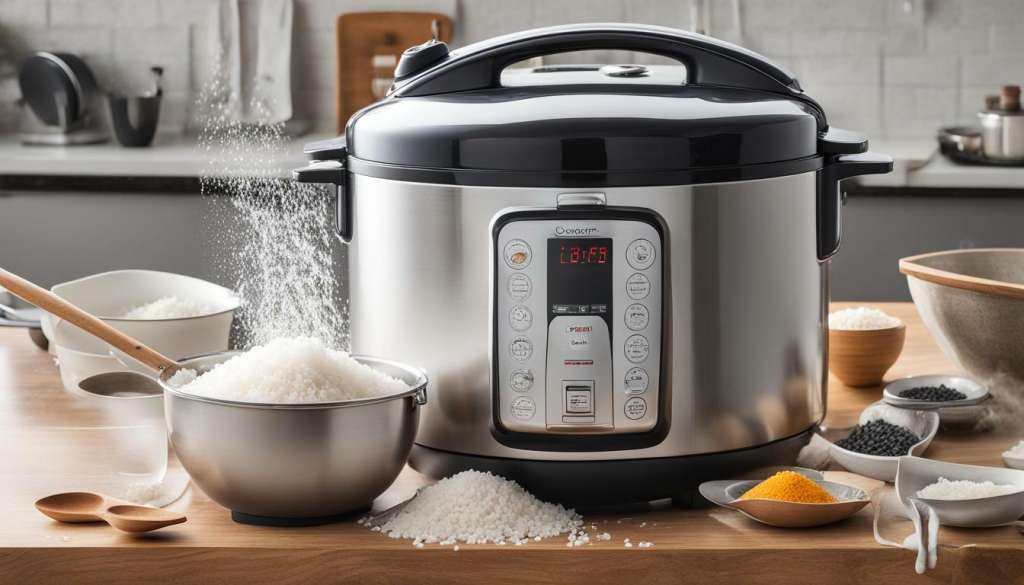
Using these techniques will help you create different rice dishes and add variety to your meals. Experiment with different flavors and ingredients to make your rice dishes even more delicious.
Rice Cooking Tips for Rice Cooker
Using a rice cooker is an easy and convenient way to prepare perfect rice every time. Here are some tips to help you achieve optimal results:
- Always measure the rice and water accurately. A general rule of thumb is to use a 1:1 or 1:2 ratio of rice to water, depending on the rice type. Be sure to refer to the instruction manual for specific measurements for your rice cooker model.
- Wash the rice before adding it to the rice cooker. This helps remove excess starch and debris and ensures fluffy, separate grains.
- Use high-quality rice for best results. Different rice varieties have different cooking times and water requirements, and some may not be suitable for use in a rice cooker.
- For added flavor, try cooking the rice in broth or adding herbs/spices before cooking.
- Once the rice is cooked, let it sit in the cooker with the lid closed for a few minutes to allow it to fully absorb the moisture.
To take your rice cooker game to the next level, try out these delicious rice cooker recipes:
| Baked Rice Pudding | Vegetable Fried Rice |
|---|---|
| A comforting dessert that’s perfect for chilly nights. Mix cooked rice with milk, sugar, cinnamon, and raisins. Bake until golden and serve warm. | A healthy and flavorful twist on the classic fried rice. Cook rice with vegetable broth and mix with sautéed veggies, garlic, and a splash of soy sauce. |
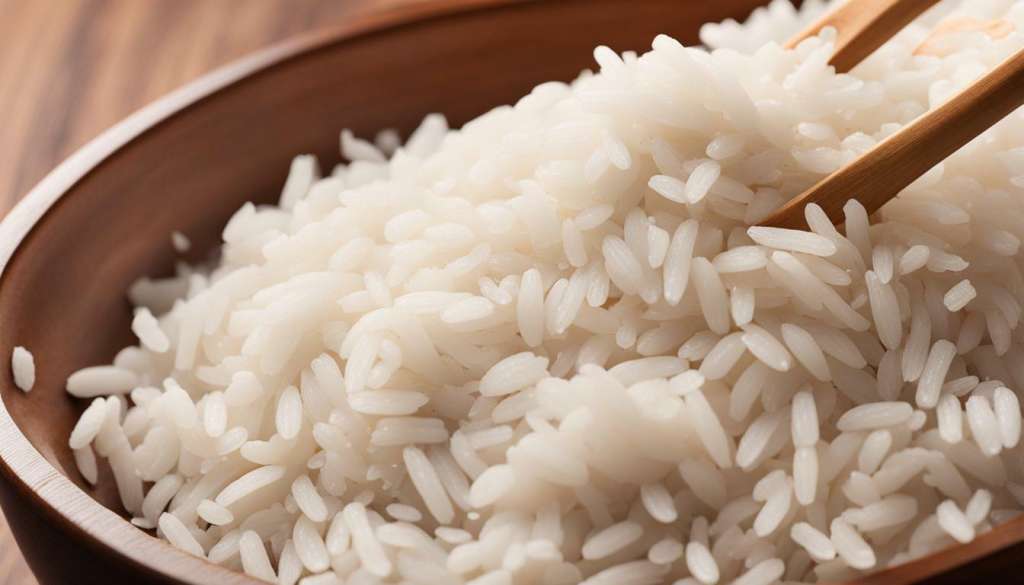 |
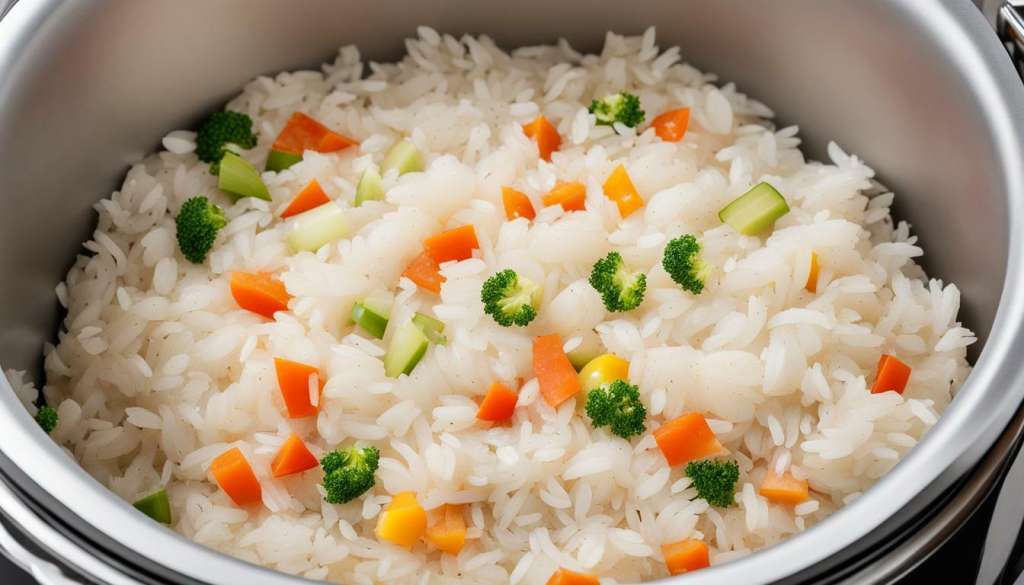 |
Experiment with different ingredients and techniques, and have fun exploring the culinary possibilities of your rice cooker!
Exploring Rice Cooker Recipes
One of the best things about using a rice cooker is the endless possibilities for delicious and easy-to-make rice dishes. Here are some mouth-watering rice cooker recipes to try:
| Recipe | Description |
|---|---|
| Teriyaki Chicken and Rice | This savory dish combines tender chicken with fluffy rice, all smothered in a sweet and tangy teriyaki sauce. Perfect for a quick and tasty weeknight dinner. |
| Coconut Rice Pudding | A delicious twist on traditional rice pudding, this recipe uses creamy coconut milk and fragrant spices to create a rich and flavorful dessert. |
| Mushroom Risotto | This creamy and comforting risotto is loaded with savory mushrooms and Parmesan cheese, and cooked to perfection in a rice cooker. |
| Spanish Rice | A classic side dish that’s bursting with flavor, this Spanish rice is made with onions, peppers, tomatoes, and a blend of fragrant spices. |
Experiment with different types of rice and flavor combinations to create your own unique recipes. Don’t be afraid to get creative and try something new in your rice cooker – the possibilities are endless!
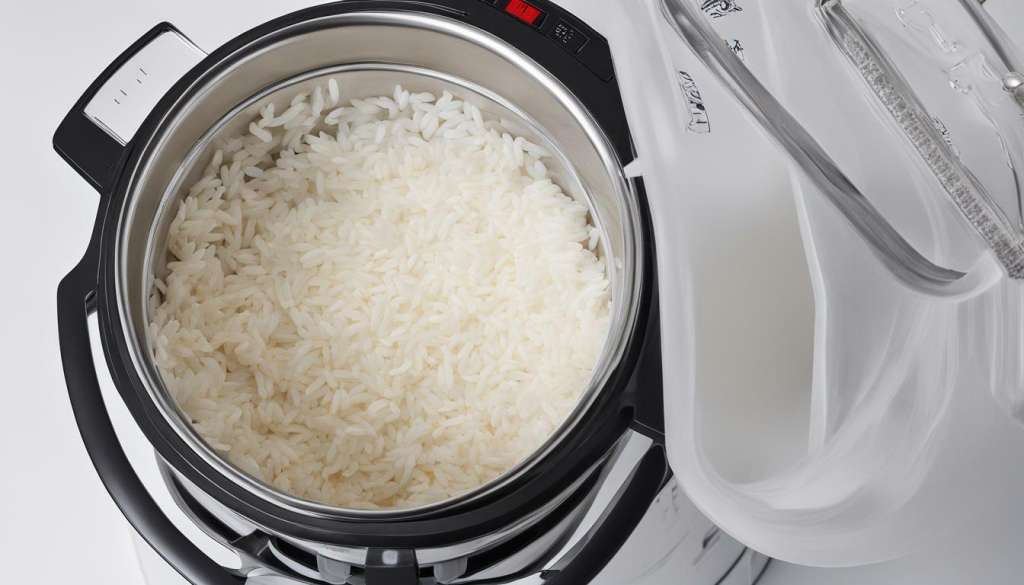
Tips for Maintaining Your Rice Cooker
To ensure your rice cooker remains in top working condition, it is important to perform regular maintenance. Here are some tips:
- Clean the rice pot after each use: After cooking rice, remove the rice pot from the cooker and wash it with warm water and dish soap. Avoid using abrasive cleaners or steel wool, as they can scratch the non-stick coating of the pot.
- Remove stubborn stains: If there are any stubborn stains in the rice pot, try soaking it in warm water and dish soap for a few hours before scrubbing it gently with a soft sponge.
- Clean the exterior of the rice cooker: Use a soft cloth and mild cleaner to wipe down the exterior of the rice cooker. Avoid getting any liquid inside the cooker.
- Check the cord and plug: Make sure the cord and plug are in good condition and not frayed or damaged. If they are, do not use the rice cooker and replace the cord or plug immediately.
- Store the rice cooker appropriately: Always store your rice cooker in a cool, dry place. Do not stack heavy objects on top of it or store it near a heat source.
- Follow the manufacturer’s instructions: Always refer to the manufacturer’s instructions for cleaning and maintenance. If you are unsure about how to clean or maintain your rice cooker, contact the manufacturer for assistance.
By following these simple maintenance tips, you can ensure your rice cooker remains in good condition and continues to produce delicious rice for years to come.
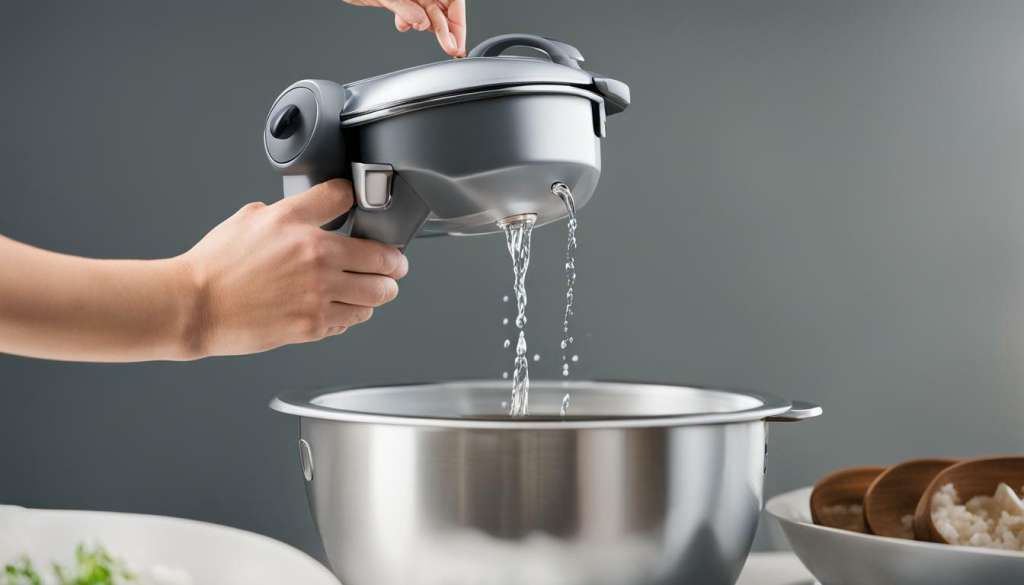
Rice Cooker Safety Measures and Precautions
Using a rice cooker is a convenient and hassle-free way to cook rice, but it’s essential to keep safety in mind while handling this appliance. By taking a few precautions, you can ensure a safe and enjoyable cooking experience that avoids any potential hazards.
Rice Cooker Safety Tips
Here are some safety tips to keep in mind when using a rice cooker:
- Always read the manufacturer’s instructions before using the rice cooker, and follow them closely.
- Never touch the rice cooker’s hot surfaces or parts with your bare hands while it’s in use or immediately after use.
- Use a heat-resistant mitt or pad when handling the rice cooker’s lid or pot.
- Keep the rice cooker away from the reach of children, as it contains hot water and steam.
- Never plug in or operate a rice cooker with a damaged electrical cord, plug, or internal parts.
- Place the rice cooker on a stable and level surface before using it, to prevent it from tipping over accidentally.
- Always unplug the rice cooker when not in use, and before cleaning it or moving it to a different location.
- Don’t use metal utensils or abrasive cleaners on the non-stick rice pot, as they can damage the surface and cause hazardous chemicals to leach into the rice.
- Don’t overfill the rice cooker with rice and water, as this can cause overflow and create a mess.
Cleaning and Maintenance
After using the rice cooker, be sure to unplug it and allow it to cool down before cleaning it. Cleaning and maintaining the rice cooker properly can help increase its lifespan and ensure optimal performance.
- Wipe the exterior of the rice cooker with a damp cloth, and dry it thoroughly.
- Remove the rice pot and wash it in warm, soapy water, using a soft sponge or cloth.
- Rinse the rice pot with clean water and dry it thoroughly.
- Don’t immerse the rice cooker’s base or electrical components in water or other liquids.
- Ensure that the rice pot is completely dry before returning it to the rice cooker.
- Inspect the rice cooker’s electrical cord and plug regularly for any signs of wear or damage, and replace them if necessary.
By following these safety measures and precautions, you can cook rice in a rice cooker with ease and peace of mind. Now that you know how to cook rice safely, let’s explore some exciting rice cooker recipes that you can try!
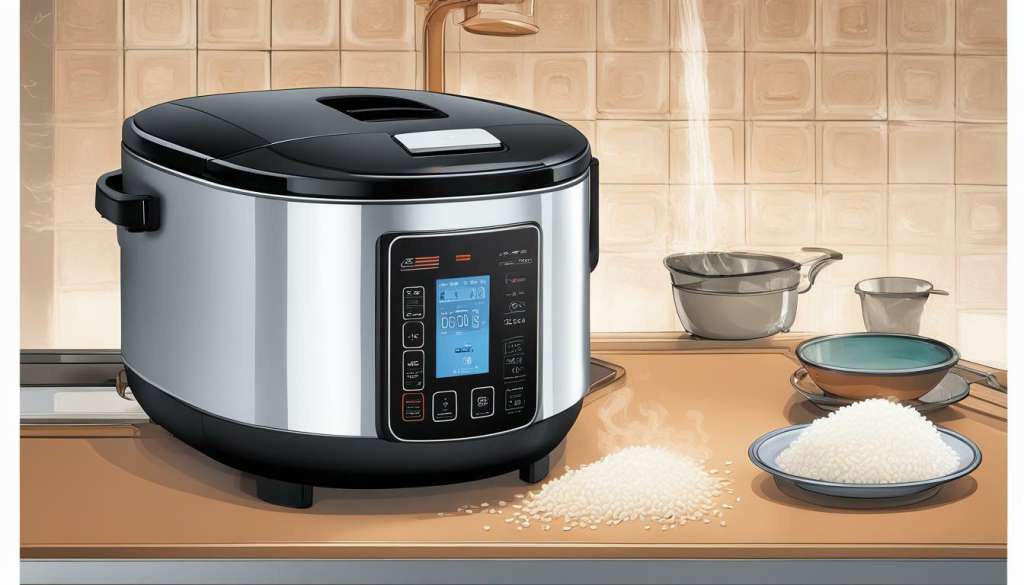
Conclusion
In conclusion, soaking rice before cooking in a rice cooker is a crucial step that enhances the flavor and nutritional benefits of rice. By following the steps outlined in this article, you can effectively soak your rice and achieve perfect results every time. Remember to select the right rice variety and use the proper water-to-rice ratio for optimal results.
Additionally, by exploring different cooking techniques and experimenting with new recipes, you can take your rice cooker usage to the next level. Don’t be afraid to get creative and try new things!
Lastly, it’s important to take care of your rice cooker to ensure its longevity and optimal performance. By following the cleaning and maintenance tips provided, you can keep your appliance in top condition and avoid any potential safety hazards.
Enhance Your Rice Cooking Skills Today
Whether you’re a seasoned cook or a beginner, mastering rice cooking in your rice cooker can be a game-changer in the kitchen. By incorporating the tips and techniques provided in this article, you can take your rice cooker usage to the next level and impress your friends and family with delicious, perfectly cooked rice dishes.
So, what are you waiting for? Get cooking and enjoy the many benefits of using a rice cooker for your rice dishes!
FAQ
Q: What is the purpose of soaking rice before cooking in a rice cooker?
A: Soaking rice before cooking in a rice cooker helps to improve flavor and texture. It also allows the rice to absorb water more evenly, resulting in a better-cooked end product.
Q: How long should I soak rice before cooking in a rice cooker?
A: The ideal soaking time for rice before cooking in a rice cooker is usually around 30 minutes. However, some varieties of rice may require longer soaking times, so it’s best to refer to the specific instructions for the type of rice you are using.
Q: What is the water-to-rice ratio for soaking rice before cooking in a rice cooker?
A: The water-to-rice ratio for soaking rice before cooking in a rice cooker is typically 2 cups of water for every 1 cup of rice. However, this ratio may vary depending on the specific type of rice you are using, so always refer to the recommended measurements for best results.
Q: Does soaking rice before cooking reduce the cooking time?
A: Yes, soaking rice before cooking can help to reduce the overall cooking time in a rice cooker. By allowing the rice to absorb water during the soaking process, it becomes more hydrated and cooks faster.
Q: Can I skip the soaking step when cooking rice in a rice cooker?
A: While soaking rice before cooking in a rice cooker is recommended for best results, it is not always necessary. Some varieties of rice, such as parboiled or quick-cooking rice, can be cooked directly in the rice cooker without soaking.
Q: Are there any scientific explanations for the benefits of soaking rice before cooking?
A: Yes, soaking rice before cooking has been shown to enhance the texture and flavor of the cooked rice. The process of soaking helps to break down the starches in the rice, making it easier to digest and allowing for better absorption of nutrients.
Q: What are the benefits of soaking rice before cooking in a rice cooker?
A: Soaking rice before cooking in a rice cooker offers several benefits. It improves the texture of the cooked rice, enhances flavor absorption, reduces cooking time, and increases digestibility. Additionally, soaking can help to remove any impurities or contaminants that may be present in the rice.
Q: What are some tips for cooking rice in a rice cooker?
A: When cooking rice in a rice cooker, it’s important to use the appropriate water measurement, choose the right type of rice for the cooker, and follow the recommended cooking techniques. Additionally, you can explore unique rice cooker recipes to add variety to your meals.
Q: What techniques can I use for cooking rice with a rice cooker?
A: There are various techniques you can try when cooking rice with a rice cooker. These include steaming, making pilaf, or preparing sushi rice. Each technique offers its own advantages and can result in different flavors and textures.
Q: How can I perfect rice cooking with a rice cooker?
A: To achieve perfect rice in a rice cooker, you can experiment with seasoning options, such as adding herbs or spices to enhance the flavor. It’s also helpful to troubleshoot any common rice cooking issues that may arise and find solutions to ensure consistent results.
Q: Can you share some rice cooker recipes?
A: Certainly! Check out our selection of delicious rice cooker recipes that showcase the versatility of this appliance. From traditional rice dishes to creative risottos and even mouth-watering desserts, there’s something for everyone to enjoy.
Q: How do I maintain my rice cooker?
A: To maintain your rice cooker, it’s important to clean the rice pot regularly and remove any stubborn stains. Follow the manufacturer’s instructions for proper cleaning and ensure that the cooker is completely dry before storing. This will help prolong its lifespan and keep it in optimal condition.
Q: What safety measures should I take when using a rice cooker?
A: When using a rice cooker, it’s important to practice electrical safety, handle hot surfaces with caution, and avoid potential hazards. Always read and follow the safety guidelines provided by the manufacturer to ensure a safe cooking experience.


